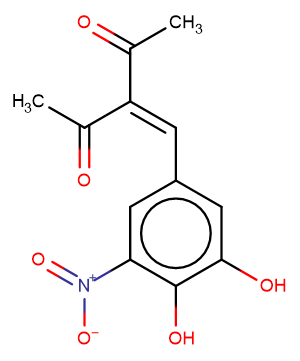
Nitecapone
CAS No. 116313-94-1
Nitecapone( —— )
Catalog No. M21089 CAS No. 116313-94-1
Nitecapone is a reversible inhibitor of S-COMT (IC50 values of 300 nM in rat liver).
Purity : >98% (HPLC)
 COA
COA
 Datasheet
Datasheet
 HNMR
HNMR
 HPLC
HPLC
 MSDS
MSDS
 Handing Instructions
Handing Instructions
| Size | Price / USD | Stock | Quantity |
| 2MG | 88 | Get Quote |


|
| 5MG | 155 | Get Quote |


|
| 10MG | 259 | Get Quote |


|
| 25MG | 440 | Get Quote |


|
| 50MG | 617 | Get Quote |


|
| 100MG | 851 | Get Quote |


|
| 200MG | Get Quote | Get Quote |


|
| 500MG | Get Quote | Get Quote |


|
| 1G | Get Quote | Get Quote |


|
Biological Information
-
Product NameNitecapone
-
NoteResearch use only, not for human use.
-
Brief DescriptionNitecapone is a reversible inhibitor of S-COMT (IC50 values of 300 nM in rat liver).
-
DescriptionNitecapone is a reversible inhibitor of S-COMT (IC50 values of 300 nM in rat liver).
-
In VitroNitecapone (1-100 μM) reducesd GSH (reduced glutathione) depletion induced by ROO-by 11-38% and oxidation to oxidized glutathione (GSSG) by 32-45%.
-
In VivoNitecapone (30 mg/kg, ip daily for 13 days) reduces development and symptoms of neuropathic pain after spinal nerve ligation in rats. Animal Model:Eighty-six male Wistar rats, weighing 140-350 g.Dosage:30 mg/kg (3.3 mL/kg).Administration:IP, once daily for 13 days.Result:Selectively and specifically inhibits COMT in the peripheral tissues, and to some extent in the CNS for ca. 3 h.Increased the thresholds for the mechanical stimuli and thus reduced mechanical allodynia.Reduced the number of positive reactions of the ipsilateral paws when compared with the baselines in the nitecapone-pretreated rats.
-
Synonyms——
-
PathwayOthers
-
TargetOther Targets
-
RecptorS-COMT
-
Research Area——
-
Indication——
Chemical Information
-
CAS Number116313-94-1
-
Formula Weight265.22
-
Molecular FormulaC12H11NO6
-
Purity>98% (HPLC)
-
SolubilityIn Vitro:?DMSO : 50 mg/mL (188.52 mM)
-
SMILESCC(=O)C(=Cc1cc(O)c(O)c([N+](=O)[O-])c1)C(C)=O
-
Chemical Name3-(34-Dihydroxy-5-nitrobenzylidene)-24-pentanedione
Shipping & Storage Information
-
Storage(-20℃)
-
ShippingWith Ice Pack
-
Stability≥ 2 years
Reference
1.P.T. M?nnist? Kaakkola S . Catechol-O-methyltransferase (COMT): Biochemistry molecular biology pharmacology and clinical efficacy of the new selective COMT inhibitors[J]. Pharmacological Reviews 2000 51(4):593-628.
molnova catalog



related products
-
Psoralen
Psoralen is used as photochemical probe in studies of DNA mutation and repair mechanisms. Causes photosensitization in human.
-
Atezolizumab
Atezolizumab anti-PD-L1) is a fully humanized IgG1 monoclonal antibody that blocks the interaction of PD-L1 with both PD-1 and B7.1 but not the interaction of PD-L2 with PD-1.
-
Pipernonaline
Pipernonaline is a useful organic compound for research related to life sciences.



 Cart
Cart
 sales@molnova.com
sales@molnova.com


